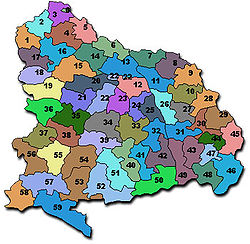Nalgonda (Telugu: నల్లగొండ, , About this sound pronunciation (help·info)) is a town and a municipality in Nalgonda district in the Indian state of Andhra Pradesh. Its name is derived from two Telugu words Nalla (Black) and Konda (hill). Nalgonda in the past is referred to as Nilagiri. During the period of Bahamani kingdom, it had been renamed as Nallagonda. Later in Nizam rule, during the later kings rule the name has been transformed into Nalgonda (for official uses). Recently A.P. govt. has changed its name to Nalgonda for convenience (for
official purpose).
Telangana Rebellion:
It has a major role in the Telangana Rebellion. Much of the struggle revolves round Nallagonda and Warangal districts alone and later spread to other regions as well. Almost all the villages in the district were involved in this. the movement was led by Andhra Maha Sabha and Communists. Marshall Law was imposed in the Dist. in 1946. Many people were killed by Razakars or by feudal lords goons and Nizam's armies. Some 3000–5000 villages were liberated and self-governing bodies were formed. Lands were distributed among the poor. Many feudal landlords " Jagirdaars " were killed or ripped of their properties. Battles raged between Communists and Razakars (and Nizam's armies ). Finally this ended with Indian Forces "Police Action" and Telangana along with Hyderabad state is merged into Indian Union.
Many leaders like Bheemireddy Narasimha Reddy, Raavi Narayana Reddy, Mallu Swarajyam (woman revolutionary) and her husband, Arutla Ramachandra Reddy and his wife, poets like Bandi Yadagiri, Suddala Hanumanthu, etc. played an important role in the movement.
Demographics:
District Map:
Mandals

| 1 Bommala Ramaram | 2 Turkapally | 3 Rajapeta |
| 4 Yadagirigutta | 5 Alair | 6 Gundala |
| 7 Tirumalagiri | 8 Thungathurthy | 9 Noothankal |
| 10 Atmakur (S) | 11 Jajireddigudem | 12 Saligowraram |
| 13 Mothkur | 14 Atmakur (M) | 15 Valigonda |
| 16 Bhongir | 17 Bibinagar | 18 Pochampally |
| 19 Choutuppal | 20 Ramannapeta | 21 Chityal |
| 22 Narketpally | 23 Kattangur | 24 Nakrekal |
| 25 Kethepally | 26 Suryapet | 27 Chivemla |
| 28 Mothey | 29 Nadigudem | 30 Munagala |
| 31 Penpahad | 32 Vemulapally | 33 Thipparthy |
| 34 Nalgonda | 35 Munugode | 36 Narayanapur |
| 37 Marriguda | 38 Chandur | 39 Kanagal |
| 40 Nidamanoor | 41 Tripuraram | 42 Miryalaguda |
| 43 Garidepally | 44 Chilkur | 45 Kodad |
| 46 Mellachervu | 47 Huzurnagar | 48 Mattampally |
| 49 Neredcherla | 50 Damercherla | 51 Anumula |
| 52 Peddavoora | 53 P.A.Pally | 54 Gurrampode |
| 55 Nampally | 56 Chintapally | 57 Devarakonda |
| 58 Gundlapay | 59 Chandampet | |
Nalgonda in the past is referred to as Nilagiri. During the period of Bahamani kingdom, it had been renamed as Nallagonda. Later in Nizam rule, during the later kings rule the name has been transformed in to Nalgonda(for official uses). But in popular culture its called as Nallagonda only. Recently A.P. govt. has changed its name to Nalgonda for convenience.But the popular name, Nallagonda, with which it is referred to by one and all and finds the name frequently even in "Poetry of the famous Telangana Liberation Struggle", should be restored back in view of its history and popular usage.
Buddha Statue:

Nagarjuna Sagar in an important Buddhist site located 150 kms from Hyderabad. The historic location takes its name from the Buddhist saint and scholar Acharya Nagarjuna who is said to have set up a centre of learning here. Today, Nagarjuna Sagar is home to Nagarjuna Sagar Dam - the world's tallest masonry dam that irrigates over 10 lakh acres of land.It was during the building of the dam that the ruins of an ancient Buddhist civilization were excavated here. Some of the relics unearthed have been carefully preserved on a picturesque island called Nagarjuna Konda, located in the centre of a man-made lake. The vestiges of a sacred Buddhist stupa, vihara, monasteries, a university and a sacrificial altar have been carefully reconstructed at Anupu on the east bank of the reservoir.
- Nagarjuna Konda:
- A fascinating island set in the middle of a man-made lake, Nagarjuna Konda houses the excavated remains of the 2nd and 3rd century Buddhist civilization found at Nagarjuna Sagar. To reach Nagarjuna Konda, visitors board a boat at the jetty near Vijayapuri township.

The nearest airport is in Hyderabad at a distance of 149 km. Rail : The nearest rail head is Macherla, which is 29 km from Nagarjuna Sagar. Bus : Regular service from Hyderabad to Nagarjuna Sagar.
The town acquired its name and fame from a sage called Yadarishi, son of the great sage Rishyasrunga who did penance inside a cave with the blessings of Anjaneya on this hill between Bhongir and Raigiri in Nalgonda district.Pleased with his deep devotion, Lord Narasimha (an incarnation of Lord Vishnu) appeared before him in five different forms as Jwala, Yogananda, Gandabherunda, Ugra and Lakshminarasimha. They later manifested themselves into finely sculpted forms that later came to be worshipped as Panchanarasimha Kshetram. As the legend goes, the Lord appeared first as Jwala Narasimha (Lord as a flame), when Yadarishi was unable to face the intensity of this apparition, he appeared in a peaceful form as Yoganarasimha (Lord in a Yogic Padmasana posture with open palms on the knees). Not satisfied with the Lord appearing alone, Yadarishi sought to see him with this consort,so he is said to have appeared with Lakshmi on his lap.






No comments:
Post a Comment